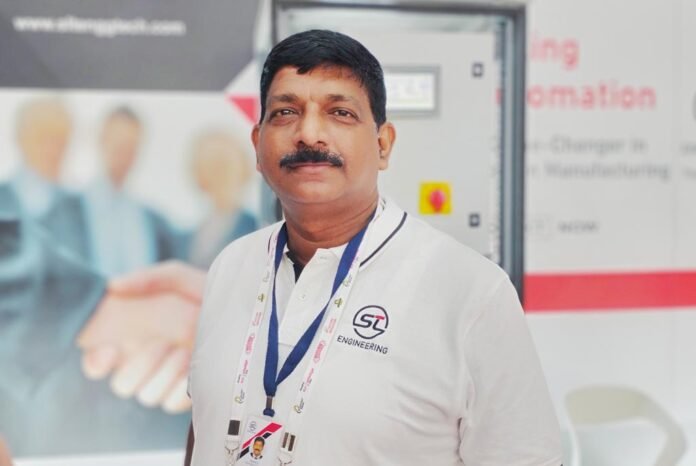Today, we’re delighted to feature a conversation with Satish K, the visionary leader and Chief Executive Officer at Sri Lakshmitech Engineering. Satish’s vision and leadership have been instrumental in revolutionizing the Indian poultry industry through specialized automation solutions. His insights provide a detailed glimpse into the current state and future trends of the Indian poultry business while also highlighting the transformative role of technology and automation in this booming sector. The in-depth discussion explores the challenges, opportunities, and advancements in the industry, making it a must-read for anyone seeking to understand or engage with the Indian poultry market.
Q: Can you describe the dynamics of the poultry sector within India’s current market landscape?
The Indian poultry market is presently in a phase of impressive growth. Several factors are contributing to this surge, including increased demand for poultry products, advancements in poultry-rearing practices, and improved distribution networks. Projections show the market’s valuation hitting the $33.25 billion mark by 2023. Continuing its upward trajectory, the market’s growth is estimated to advance at a 9% compound annual growth rate (CAGR) from the years 2024 through 2026. This continuous upward trajectory indicates the sector’s robustness and resilience, signifying an era of significant opportunities for stakeholders in the poultry business. The industry is expected to see even more technological advancements and automation solutions, which will make poultry rearing more efficient, thus driving further growth.
Q: What factors are driving this impressive growth in the Indian poultry market?
The remarkable growth witnessed in the Indian poultry sector is the result of a confluence of significant elements. The escalating demand for poultry products, particularly chicken and eggs, due to a rising population and dietary shifts towards protein-rich foods is the primary driver. Additionally, the proliferation of quick-service restaurants and the expansion of retail food chains across the country have greatly spurred poultry consumption. Government initiatives aimed at rural poultry farming development and improved breeds offer further impetus. Lastly, advancements in poultry farming techniques, such as the use of automated machinery for feed mixing provided by companies like Sri Lakshmitech Engineering, are significantly boosting the productivity and scalability of poultry businesses.
Q: Could you elaborate on the significant challenges that the poultry business in India is facing today?
The Indian poultry industry, while experiencing significant growth, is not without its challenges. High feed costs are a primary concern, as they constitute about 70% of the cost of poultry farming. The industry relies heavily on maize and soybean meal, the prices of which are highly volatile and subject to market fluctuations, resulting in inconsistent costs and potentially squeezing profit margins.
Additionally, the industry is often threatened by outbreaks of poultry diseases, such as Avian Influenza, Newcastle Disease, and Infectious Bursal Disease. These diseases can decimate poultry populations, impacting both the supply of poultry products and the profitability of the business. While measures are taken to prevent such diseases, their occurrence can disrupt the entire supply chain and cause significant economic losses.
The need for structured marketing channels is another major challenge. The majority of poultry sales in India happen through traditional markets, making it difficult for producers to reach a wider audience and limit their potential for growth. The absence of a streamlined supply chain also results in a lack of transparency and traceability, which can lead to issues with product quality and safety. The industry needs to invest in developing structured, modern marketing channels that can support the growth and evolution of the Indian poultry market.
Q: How is technology changing the poultry business in India?
Technology is indeed transforming the poultry business landscape in India. Automated feeding systems, for instance, are optimizing the process of feed distribution, ensuring that each bird receives a balanced and consistent diet. Equipped with advanced sensors, these systems dynamically monitor and adjust feed portions in alignment with the nutritional requirements of the birds. This approach not only optimizes the health of the birds but also curtails unnecessary waste, translating into economic benefits.
Advanced disease detection mechanisms are another significant technological advancement in the poultry industry. With the integration of Artificial Intelligence (AI) and the Internet of Things (IoT), these platforms have the potential to identify and alert about possible epidemics in advance. They do this by constantly monitoring the birds’ behaviour and environment and identifying any anomalies that may indicate the onset of disease. Catching ailments at an early stage enables immediate action, limiting disease dissemination and lessening prospective damage.
In addition, automation and data analytics are being used to monitor and manage every aspect of poultry rearing, from egg production to bird growth. Consequently, this advancement has heightened production efficacy, refined the caliber of poultry goods, and optimized the efficiency of farm operations. As such, technology is not only addressing the challenges in the Indian poultry business but also paving the way for its future growth and sustainability.
Q: Can you elaborate on the role of Sri Lakshmitech Engineering in the Indian poultry industry?
Sri Lakshmitech Engineering’s revolutionary liquid applicators are transforming poultry feed milling operations. These applicators are designed to apply a precise amount of liquid additives to the poultry feed during the milling process, enhancing the nutrient value of the feed. The technology ensures even distribution of additives, which can include enzymes, vitamins, and other essential supplements, across the entirety of the feed. This results in a uniform, high-quality product that optimizes bird health and productivity. The precision and effectiveness of our liquid applicators not only improve feed efficiency but also promote sustainability by reducing waste. By simplifying the feed milling process and enhancing the quality of the poultry feed, Sri Lakshmitech Engineering is playing a critical role in the technological advancement of the Indian poultry industry.
Q: Could you tell us more about the innovative solutions your company has developed?
Sri Lakshmitech Engineering’s innovative solutions are designed to revolutionize the poultry industry. The Cold Mash Conditioning technology helps in the thorough mixing of feed ingredients with steam. This process increases the digestibility and nutritional value of the feed, improving the overall health and productivity of the birds.
The company also offers Special-Purpose Machines tailored to improve various aspects of the poultry farming process. Advanced machinery in poultry feeds, from converting feed to its final processing, streamlines productivity and minimizes the need for human intervention.
The Post Pellet Liquid Applicator is a unique solution that allows liquid additives to be effectively applied to feeds after the pelleting process. This ensures that these additives, which may include vitamins or enzymes, are evenly distributed in the feed, enhancing its nutritional value.
Innovations with Enzymatic Systems include both singular and collective enzyme configurations. These systems are designed for dosing enzymes in the feed accurately. Enzymes play a critical role in bird’s digestion and nutrient absorption, making this system a valuable tool for optimizing bird health and productivity.
The Liquid Additive Dosing Systems offer precision in the application of liquid additives in the feed. These systems ensure that the correct dosage of liquid additives, such as vaccines or nutrients, is applied evenly across the feed, promoting effective absorption and optimal health for the birds.
Lastly, the Moisture Optimization Unit is designed to control the moisture content of the feed. This unit ensures the feed maintains an optimal moisture level that enhances its quality and shelf life. By avoiding excess moisture, the risk of bacterial growth in the feed is minimized, contributing to the overall health and safety of the poultry.
Q: What is the market’s reaction to the newly implemented automation technologies?
The market’s positive reception to automation solutions is becoming increasingly apparent as many poultry businesses start to recognize and benefit from the value of these innovations. The transition from traditional methods to automated systems has resulted in significant cost savings, mainly driven by increased efficiency and reduced waste. For example, the use of automated feeding systems and liquid additive dosing systems ensures precise and optimal nutrition for the birds, cutting down on feed waste and contributing to bird health, which, in turn, boosts productivity.
Moreover, special-purpose machines tailored for various aspects of poultry farming are reducing the reliance on manual labour, streamlining operations and further cutting down costs. The increased productivity and quality due to automation also strengthen the business’s competitive edge in the market. The rising use of automation in poultry farming clearly reflects its practical advantages and the significant improvements it brings to the industry.
Q: What are your plans for Sri Lakshmitech Engineering in the Indian poultry market?
As we progress, our primary objective is to stay at the forefront of technological advancements and to consistently introduce innovative products that meet the changing needs of the poultry industry. The future of this industry lies in digitalization and automation, and we are committed to developing solutions that facilitate this transition. Our research and development team is continually working on creating advanced automation solutions that not only improve efficiency and productivity but also enhance the well-being of the birds and ensure the sustainability of operations. We are also keen on expanding our product portfolio to cater to a broader range of requirements within the poultry industry. Our plans also include enhancing our customer support services to ensure that our clients can seamlessly adopt and benefit from our solutions. Therefore, by focusing on innovation, customer satisfaction, and industry development, we aspire to continue shaping the future of the Indian poultry industry.
Q: What trajectory of evolution can we expect for the Indian poultry sector in the upcoming half-decade?
The Indian poultry industry, in the coming five years, is expected to undergo a significant transformation fueled by technological advancements. We anticipate a rise in the adoption of specialized machinery and automated solutions, such as advanced feeding systems, liquid additive dosing systems, and moisture optimization units. These innovations are geared towards enhancing efficiency, streamlining operations, and reducing waste, thus contributing to improved profitability.
Moreover, the industry is likely to move towards more sustainable practices. It is imperative to shift toward technologies that facilitate resource conservation and diminish environmental degradation. For instance, precision farming technologies will enable optimal use of feed, water, and energy. At the same time, waste management solutions will help convert poultry waste into valuable by-products, aiding in the circular economy.
Advancements in biosecurity measures will also play a pivotal role in sustaining the health and productivity of the poultry, hence ensuring food security. Digital technologies like data analytics, artificial intelligence, and the Internet of Things (IoT) will help in disease prediction and prevention, thereby reducing losses and ensuring a consistent supply of safe, high-quality poultry products.
In a nutshell, the future of the Indian poultry industry is envisioned as an interconnected ecosystem of advanced, efficient, and sustainable practices that maximize profitability while ensuring food security.
Q: What tips would you suggest for someone aspiring to break into the Indian poultry industry?
For those entering the poultry business in India, technological advancements offered by companies like Sri Lakshmitech Engineering can indeed be game-changers. This is primarily because the technology optimizes various aspects of poultry farming – from feeding to health maintenance – resulting in increased efficiency and profitability. For instance, automated feeding systems ensure accurate dosing of feed and nutrients, thereby reducing wastage and ensuring the birds receive optimal nutrition. Similarly, liquid additive dosing systems accurately administer vaccines and other additives, enhancing bird health and productivity. These intelligent systems not only save time and resources but also contribute to better product quality, giving your poultry business a competitive edge in the market. Furthermore, the move towards digitalization enables data-driven decisions, maximizing operational efficiency and profitability. Thus, embracing technological advancements can significantly enhance your poultry business operations, making them more sustainable, efficient, and profitable.




